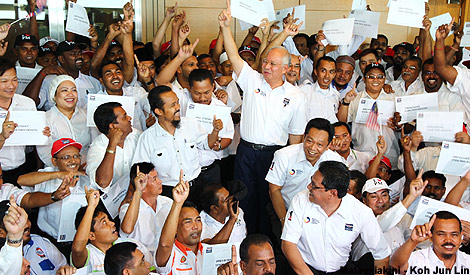FOCUS The rise of ride-sharing mobile applications, such as Uber, has disrupted the status quo of the taxi industry, with drivers seeing their share of the income pie being increasingly taken away by such online services.
In the first two instalments of this four-part series, Malaysiakini sought to explain why taxi drivers blame Uber for their shrinking income and the costs conventional cabbies pay just to keep the wheels turning .
In this third part, we look at what dampens reform in the local taxi industry and the best practices beyond our shores.
The response across the world in dealing with Uber has normally been either to ban the service, or reform the whole industry - which can prove a tedious process.
For Malaysia, the authorities' response has been confusing, with the Road Transport Department and the Land Public Transport Commission (Spad) in October vowing to crack down on Uber, only to backtrack a few days later.
Spad, in its U-turn, said it understood the solutions provided by services like Uber and GrabCar and also people's sentiments towards this service.
 To put it bluntly, Spad acknowledged there is public support for ride-sharing services as an alternative to Malaysian taxis which have been ranked as the "world's worst" by UK-based taxi comparison site
londoncabs.co.uk
.
To put it bluntly, Spad acknowledged there is public support for ride-sharing services as an alternative to Malaysian taxis which have been ranked as the "world's worst" by UK-based taxi comparison site
londoncabs.co.uk
.
A Malaysiakini online survey yesterday found similar results, with the majority of readers blaming taxi drivers and Spad - instead of Uber - for the ongoing tussle.
This was despite Malaysiakini highlighting that three in four taxi drivers in Kuala Lumpur are forced to pay high charges - for their taxi licence and vehicle rental - to well-connected private companies.
Reluctant reforms
It is precisely the sorry state of the Malaysian taxi industry that has made banning Uber and similar services not as straightforward as it can be, unlike in countries such as Spain and France.
 Even before Uber became widespread in Malaysia, there were already acknowledgements that reforms were needed but they have often been half-hearted.
Even before Uber became widespread in Malaysia, there were already acknowledgements that reforms were needed but they have often been half-hearted.
Prime Minister Najib Abdul Razak - at a rally by taxi drivers before the 13th general election - pledged to increase the number of individual taxi licences.
Najib also announced an exemption of excise duty for Proton cars purchased by taxi drivers with individual licence.
But, as reported by Malaysiakini yesterday, the number of individual taxi licences in Kuala Lumpur this year makes up a meagre 28.2 percent, compared with 71.8 percent of the licences that are not owned by taxi drivers themselves.
In a parliamentary written reply in June this year, the government also revealed it was no longer issuing licences for new taxis, particularly metered ones, as "supply has outstripped demand".
The Uber can serve as an opportunity for the government to push forward long overdue reforms on the taxi industry, which has been struggling when it comes to inspiring public confidence.
Level the playing field
The reform can start by breaking up the monopoly of taxi licences by private companies and giving them directly to taxi drivers themselves.
“The government should re-register all taxis, cancel the cronies’ taxi permits. This would make them (drivers) free from 14 to 16 hours working time, just to earn a little income," said DAP parliamentary researcher Chung Yi Fan.
Chung, who is a keen observer of the transportation policy, said this can help revive the competitiveness of taxi drivers.
As highlighted by yesterday's Malaysiakini report, while the operations cost of taxis with non-individual licences is almost double that of Uber cars, taxi drivers with their own licences can still give the ride-sharing application a run for its money.
Taxi drivers with their own licences only need to pay RM150 over a period of five years for the licence, compared with non-individual licence holders who pay RM18 per day to private companies, translating to a whopping RM6,570 a year or RM32,850 for five years.

Putrajaya can also learn from the taxi industry reforms instituted by the Australia Capital Territory (ACT) in Canberra, where it also introduced a Uber-like application called Transport Booking Service for taxi drivers to compete with Uber.
By legalising Uber, the ACT government said all ride-sharing services must undergo similar processes as taxi drivers, including car inspections, driver assessments, driver medical check-up and the necessary insurance.
This does not only ensure the interest of passengers is protected but also creates a more equal playing field for both Uber and regular taxi drivers.
Under the reform, Uber drivers are also prohibited from picking up passengers from bus and taxi zones, in a move to protect conventional taxis.
Spad on Monday indicated that it was drafting a proposal for legislative changes to cope with the advent of ride-sharing application.
However, it remains to be seen what kind of reforms Spad is planning and whether there would be political will to break the entrenched monopoly of licences by well-connected private companies.
In the next and final part, Malaysiakini will look at the challenges faced by Uber, including whether passengers are adequately protected, since the ride-sharing service is not subjected to rigorous regulatory processes.
RELATED STORIES:
PART I: The taxi-Uber war: A tale of two drivers
PART II: Sky-high fees doom cabbies to being Uber-losers
PART IV: Insurers: Private car insurance does not cover Uber drivers

